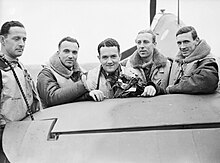Zakłady Mleczarskie K. Henneberga

The Zakłady Mleczarskie K. Henne Berga (German: Dairy K. Henneberg ), later Zakłady Mleczarskie Romana Rekierta , was the first in Warsaw built dairy and was in the ul Koszykowa 25th in the downtown district of the city. The company was founded in the second half of the 19th century by a member of the German-born, Protestant Henneberg family from Augsburg and remained in family ownership until 1909. The company was nationalized after the Second World War and no longer exists today.
history
Karol Jan Henneberg (1834–1906), a son of Karol August Henneberg (1808–1864), founded the dairy in Warsaw in 1876. He was a merchant and owner of an estate near Mińsk Mazowiecki , on which he raised high-yielding cows. Henneberg's brothers Juliusz (1835–1907) and Wilhelm (1844–1917) Henneberg had founded the “Bracia Henneberg” tableware factory - Fabryka Platerów - also in Warsaw in 1857 .
The Henneberg dairy initially had 2 sales outlets - at ul. Rymarskiej 2 and at ul. Hr. Berga 2 . In 1890 the company moved into a new production building in ul. Koszykowa . The company's annual turnover in the 1890s was about 47,000 rubles . 50 people were employed in production, a further 12 as carters. There were also staff in the company's own sales outlets. The company had three gas machines with a total output of 160 hp, which were used to operate the dairy processing plants.
The dairy was one of the most modern companies of its kind in the Weichselland . For the first time, the industrial production of milk powder for babies was realized here. The powder was sold under the brand name Albuminozy Henneberga (German: Hennebergs Albuminose ) in pharmacies and grocery stores . A display of the time described the benefits of the product:
“ Albuminoza wplywa na szybki przyrost wagi, ulatwia ząbkowanie i wzmacnia mięśnie i kości, usuwając w ten sposób tak bardzo rozpowszechniuną krzywicę (chorobę angielską). Jako pokarm najłatwiej strawny i bardzo pożywny, Albuminoza nadaje się również dla osób wszelkiego wieku, osłabionych długotrwalą chorobą, dla chorych na bledźnicę, niedokrwistńośćod wyciezichkolę
German: Albuminosis leads to rapid weight gain, promotes tooth formation, strengthens muscles and bones and prevents rickets (known as English disease). Easily digestible and very nutritious food, albuminosis is also suitable for people of all ages who have been weakened by long-term illnesses, including those with chlorosis , anemia , tuberculosis and exhaustion of all kinds. "
The dairy supplied consumers in the Warsaw metropolitan area. A bottle of kefir ordered by subscription cost 8 kopecks shortly before the outbreak of the First World War . Milk, butter, cream products, cheese and eggs were also offered. In addition, a network of milk drinking halls was created, which were called Mleczarniami Henneberga (German: Hennebergsche Milchladen ). Company coins were issued in these milk-drinking halls to pay the waiters; Such a coin system (equivalent of one coin: 1/2 liter of milk) was also used for home deliveries.
Adolf Romuald (1874–1937), a son of Karol Jan Henneberg, took over his father's company. The new entrepreneur invested in extensive modernization and expansion of the manufacturing facilities. A machine-driven milk centrifuge and a cooling basin to cool the milk down to about 3 degrees were purchased. A homogenizer imported from Paris based on the Auguste Gaulin system , a bottle washing system (capacity: 100 bottles / hour), an aluminum lid bottle closure system, a cream refrigerator and ice machines were also installed. A modern laboratory was also set up. The investments should lead to an increase in turnover to 300–400,000 rubles / year. This goal was not achieved and in 1909 Henneberg was on the verge of bankruptcy. He sold the dairy to the manager Roman Rekiert and the landowner Henryk Koźmiński. The company's name was changed to the limited partnership Roman Rekiert i Ska . After the Second World War, the company was nationalized and later liquidated.
literature
- Zofia Jurkowlaniec and Roland Borchers, Polacy z wyboru: Rodziny pochodzenia niemieckiego w Warszawie w XIX i XX wieku / Poland of free choice: Families of German origin in Warsaw in the 19th and 20th centuries , ISBN 978-83-62020-46-1 , Fundacja Wspołpracy Polsko-Niemieckiej / Dom Spotkań z Historią, Warsaw 2012
Web links
- Zakłady Mleczarskie Romana Rekierta daw. K. Henneberga ul.Koszykowa 25 at: Made in Warszawa (madein.waw.pl), Stowarzyszenie Nasz Norblin , 2008, accessed on March 11, 2014 (in Polish)
- Wystawa Higieniczna w 1896. Pawilon mleczarni K. Henneberga , photo of an exhibition pavilion from 1896, at: Warszawa1939.pl , accessed on March 11, 2014 (in Polish)
- Henneberg in: Poland of free choice , see bibliography below
- Pamiątki numizmatyczne po zakładach mleczarskich Karola Henneberga on the Warsaw Numismatic Society ( Warszawskie Towarzystwo Numizmatyczne )website, accessed on March 11, 2014 (in Polish)
Individual evidence
- ↑ Działalność gospodarcza. Zakłady przemysłowe i firmy kupieckie należące do ewangelików
- ↑ The Prussian family settled in Poland in the middle of the 18th century. The oldest known representative of the family was Berlin-born Johann Friedrich Henneberg (1768–1819), owner of the Strzyżew and Szczytno estates in the Sochaczew district . His son was Karol August Hennberg (1808–1864), a participant in the Polish November uprising
- ↑ a b newspaper advertisement Albuminoza Henneberga in: Biesiada Literacka 1907 , No. 17 (1634) from April 26, 1907 (in Polish, accessed on May 10, 2014)
- ↑ a b Photo and description of the coin under 1460. Warszawa, Roman Rekiert i Ska - nominał 5 ( Memento from August 11, 2014 in the Internet Archive ) at the coin auction house Gabinet Numizmatyczny DT Marciniak (in Polish, accessed on May 12, 2014)
- ↑ Adolf Romuald's eldest son was the farmer Wacław Adolf (1902–1964), the youngest Zdzisław Karol Henneberg (1911–1941), major and commander of the Polish RAF Fighter Squadron 303 , which took part in the Battle of Britain . He fell on an operation over France.
